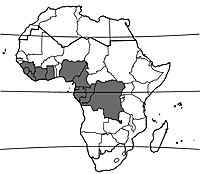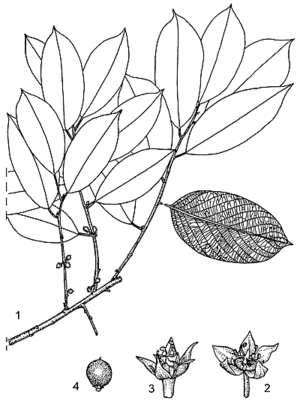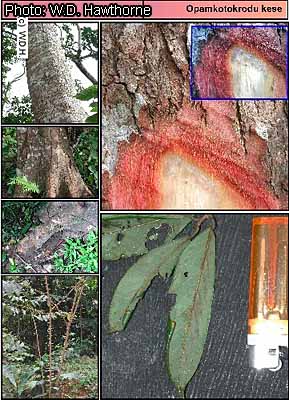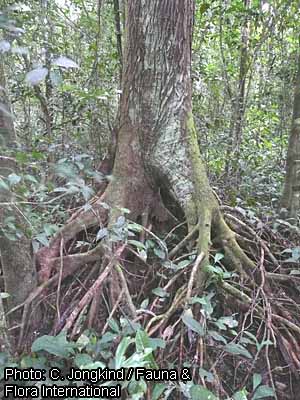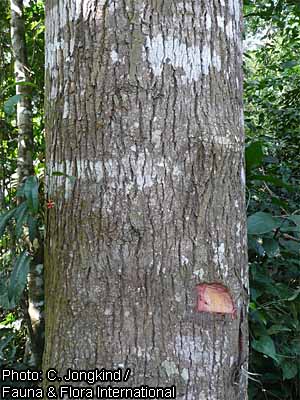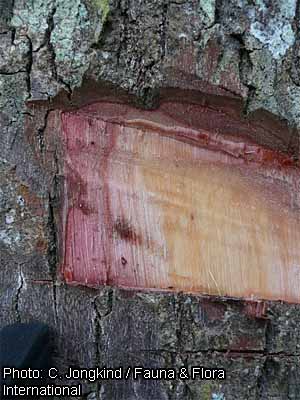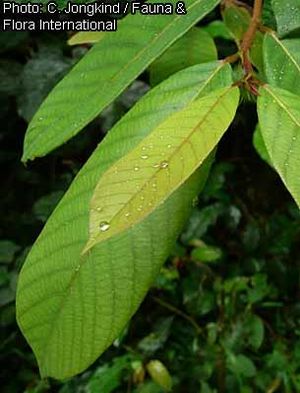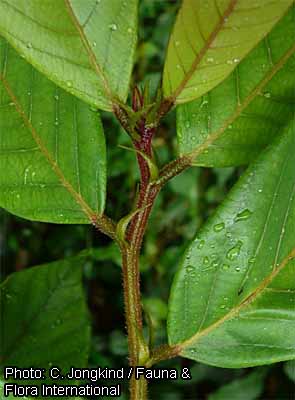Bridelia grandis (PROTA)
Introduction |
Bridelia grandis Pierre ex Hutch.
- Protologue: Dyer, Fl. trop. Afr. 6(1): 1042 (1913).
- Family: Euphorbiaceae (APG: Phyllanthaceae)
Synonyms
- Bridelia aubrevillei Pellegr. (1931).
Origin and geographic distribution
Bridelia grandis is distributed from Guinea and Sierra Leone eastward to DR Congo.
Uses
In Sierra Leone the wood of Bridelia grandis is used for light construction and furniture. In Côte d’Ivoire it is one of the preferred woods for canoes. In Gabon branches are used for the construction of roofs. The wood is suitable for light flooring, joinery, interior trim, mine props, vehicle bodies, railway sleepers, toys, novelties, ladders, handles, boxes, crates, pattern making, turnery, veneer and plywood. It is widely used as firewood.
In Côte d’Ivoire bark decoctions or macerations are taken as a purgative, diuretic, febrifuge, anodyne and aphrodisiac. The bark is also used in a wash or a vapour bath to relieve rheumatic pains. In Cameroon pygmy people use the bark in dental care. In Liberia palm wine to which bark has been added is drunk by women to stimulate lactation.
Production and international trade
The timber is traded under the name ‘asas’ or ‘assas’ but quantities are small and statistics are not available. Considerable amounts of bark are traded on local markets for medicinal purposes, but also for this trade statistics are not available.
Properties
The heartwood is grey-brown or brown, often mottled and lustrous, and not well demarcated from the up to 6 cm wide sapwood. The grain is interlocked, texture very fine. The wood has some resemblance to that of walnut (Juglans spp).
The wood is medium-weight, with a density of 590–670 kg/m³ at 12% moisture content, fairly hard and strong. The rates of shrinkage during drying are moderate, from green to oven dry about 3.1% radial and 7.6% tangential. The wood air dries slowly but satisfactorily without much degrade. After drying, it is stable in service. At 12% moisture content, the modulus of rupture is 105–127 N/mm², modulus of elasticity 10,600 N/mm², compression parallel to grain 53–57 N/mm², cleavage 18.5–20.5 N/mm and Chalais-Meudon side hardness 2.5–2.7.
The wood saws and planes well and if a reduced cutting angle is used it can be finished to an excellent surface. It holds nails and screws satisfactorily, and glues well, and it is easy to peel and slice. The heartwood is moderately durable, having some resistance to termite attack; the sapwood is susceptible to Lyctus attack. The wood is an excellent firewood and produces good charcoal.
The wood contains about 44% cellulose, 28.5% lignin, 15% pentosan and 0.8% ash. The solubility is 7.3% in alcohol-benzene, 2.7% in hot water and 14.9% in a 1% NaOH solution.
The bark has antibacterial activity against Streptococcus spp., as well as antitrypanosomal and antiplasmodial activities. The medicinal properties have been attributed to the presence of tannins and saponosides.
Adulterations and substitutes
The timber of Bridelia grandis shares its trade name with that of Bridelia micrantha Baill. and the timber of both species is mixed in trade.
Description
- Evergreen, monoecious, small to medium-sized tree up to 30 m tall; bole branchless for up to 15 m, usually straight and cylindrical, up to 90 cm in diameter, in lower part usually with stout aerial roots up to 60 cm long extending into ridges up to 1.2 m high along the bole; bark surface with deep longitudinal fissures, brown-black, inner bark fibrous, red, strongly scented; crown rounded, fairly open, heavily branched; branches often with long, straight spines; twigs rusty-brown soft-hairy, becoming glabrous.
- Leaves alternate, distichous, simple and entire; stipules 6–10 mm long, caducous; petiole 4–8 mm long; blade elliptical to obovate, 6–14 cm × 2–6 cm, base rounded to broadly cuneate, apex acuminate, glabrous to slightly hairy above, with soft and spreading hairs below, pinnately veined with 8–10(–13) pairs of lateral veins.
- Inflorescence a small axillary fascicle.
- Flowers unisexual, regular, 5(–6)-merous; sepals triangular, 1–1.5 mm long, with few scattered hairs; petals small, c. 0.5 mm long; disk ring-shaped; male flowers with pedicel c. 1.5 mm long, stamens with filaments fused in a column below, free and spreading above, ovary rudimentary; female flowers nearly sessile with superior, 2-celled ovary, styles 2, fused at base, 2-branched.
- Fruit a nearly globose, fleshy drupe c. 7 mm in diameter, dark purple to black when ripe, 1-seeded.
- Seed c. 5 mm long, brownish.
- Seedling with epigeal germination; hypocotyl 3–4 cm long, epicotyl c. 1 cm long, reddish hairy; cotyledons leafy, transversely oblong, 8–10 mm × 11–15 mm; first leaves alternate.
Other botanical information
Bridelia occurs in the Old World tropics, and comprises about 75 species. About 15 species occur in mainland tropical Africa and 2 species are endemic to the Indian Ocean islands.
Anatomy
Wood-anatomical description (IAWA hardwood codes):
- Growth rings: 1: growth ring boundaries distinct; 2: growth ring boundaries indistinct or absent.
- Vessels: 5: wood diffuse-porous; 13: simple perforation plates; 22: intervessel pits alternate; 23: shape of alternate pits polygonal; 26: intervessel pits medium (7–10 μm); (30: vessel-ray pits with distinct borders; similar to intervessel pits in size and shape throughout the ray cell); 31: vessel-ray pits with much reduced borders to apparently simple: pits rounded or angular; 32: vessel-ray pits with much reduced borders to apparently simple: pits horizontal (scalariform, gash-like) to vertical (palisade); 34: vessel-ray pits unilaterally compound and coarse (over 10 μm); 42: mean tangential diameter of vessel lumina 100–200 μm; 47: 5–20 vessels per square millimetre.
- Tracheids and fibres: 61: fibres with simple to minutely bordered pits; 66: non-septate fibres present; 69: fibres thin- to thick-walled.
- Axial parenchyma: 78: axial parenchyma scanty paratracheal; 93: eight (5–8) cells per parenchyma strand.
- Rays: 97: ray width 1–3 cells; 102: ray height > 1 mm; (106: body ray cells procumbent with one row of upright and/or square marginal cells); 107: body ray cells procumbent with mostly 2–4 rows of upright and/or square marginal cells; 108: body ray cells procumbent with over 4 rows of upright and/or square marginal cells; 109: rays with procumbent, square and upright cells mixed throughout the ray; (110: sheath cells present); 115: 4–12 rays per mm.
- Mineral inclusions: 136: prismatic crystals present; 137: prismatic crystals in upright and/or square ray cells; 138: prismatic crystals in procumbent ray cells; 140: prismatic crystals in chambered upright and/or square ray cells; 142: prismatic crystals in chambered axial parenchyma cells; 143: prismatic crystals in fibres.
Growth and development
The tree grows rapidly. Seedlings reached 12 cm tall 3 months after sowing and 50 cm after 6 months. In Guinea they reached on average 2.9 m tall 2 years after planting in full sun, but only 1.1 m in light shade. In open sites trees reached a height of 12 m and a bole diameter of 15 cm 7 years after planting. In Côte d’Ivoire trees with a bole diameter of 80 cm have been recorded in secondary forest of 40 years old. In Liberia and Côte d’Ivoire Bridelia grandis usually flowers from April till June and fruits can be found from August to November. In Guinea trees fruit in December–January. The flowers have a pleasant smell. The fruits are probably dispersed by birds.
Ecology
Bridelia grandis is a typical pioneer species; hence seedlings and saplings are more abundant in recently logged forest than in undisturbed forest. Bridelia grandis prefers moist conditions, and occurs especially in swampy localities.
Propagation and planting
Propagation with seed is easy. There are about 25,000 seeds per kg. Seeds start germinating 1–3 weeks after sowing and the germination rate is high, over 90%. Seedlings tolerate some shade. Seedlings are ready for planting in the field when they are 30 cm tall, which is about 4 months after planting them in nursery pots. It is recommended to plant at a spacing of 3 m × 3 m.
Diseases and pests
Elephants eat the leaves of Bridelia grandis and may cause damage in plantations.
Harvesting
In the Central African Republic and Gabon, the minimum bole diameter allowed for felling is 70 cm.
Genetic resources
There are no indications that Bridelia grandis is threatened by genetic erosion, although it has been recorded as not very common in Liberia. As a pioneer that is commonly found in disturbed and secondary forest, it is not likely to become endangered.
Prospects
There is little information on growth rates and appropriate silvicultural management of Bridelia grandis, but it might be an interesting timber tree with potentially economic importance because it seems to be able to grow rapidly and to propagate easily. Increased pharmacological interest also seems justified.
Major references
- Bolza, E. & Keating, W.G., 1972. African timbers: the properties, uses and characteristics of 700 species. Division of Building Research, CSIRO, Melbourne, Australia. 710 pp.
- Burkill, H.M., 1994. The useful plants of West Tropical Africa. 2nd Edition. Volume 2, Families E–I. Royal Botanic Gardens, Kew, Richmond, United Kingdom. 636 pp.
- de Koning, J., 1983. La forêt de Banco. Part 2: La Flore. Mededelingen Landbouwhogeschool Wageningen 83–1. Wageningen, Netherlands. 921 pp.
- Raponda-Walker, A. & Sillans, R., 1961. Les plantes utiles du Gabon. Paul Lechevalier, Paris, France. 614 pp.
- Sallenave, P., 1955. Propriétés physiques et mécaniques des bois tropicaux de l’Union française. Centre Technique Forestier Tropical, Nogent-sur-Marne, France. 129 pp.
- Savard, J., Besson, A. & Morize, S., 1954. Analyse chimique des bois tropicaux. Publication No 5, Centre Technique Forestier Tropical, Nogent-sur-Marne, France. 191 pp.
- Takahashi, A., 1978. Compilation of data on the mechanical properties of foreign woods (part 3) Africa. Shimane University, Matsue, Japan. 248 pp.
- Voorhoeve, A.G., 1965. Liberian high forest trees. A systematic botanical study of the 75 most important or frequent high forest trees, with reference to numerous related species. Pudoc, Wageningen, Netherlands. 416 pp.
Other references
- Adjanohoun, E.J. & Aké Assi, L., 1979. Contribution au recensement des plantes médicinales de Côte d’Ivoire. Centre National de Floristique, Abidjan, Côte d’Ivoire. 358 pp.
- Atindehou, K.K., Koné, M., Terreaux, C., Traoré, D., Hostettmann, K. & Dosso, M., 2002. Evaluation of the antimicrobial potential of medicinal plants from the Ivory Coast. Phytotherapy Research 16(5): 497–502.
- Atindehou, K.K., Schmid, C., Brun, R., Koné, M.W. & Traoré, D., 2004. Antitrypanosomal and antiplasmodial activity of medicinal plants from Côte d’Ivoire. Journal of Ethnopharmacology 90(2): 221–227.
- Brusotti, G., Ngueyem, T.A., Biesuz, R. & Caccialanza, G., 2010. Optimum extraction process of polyphenols from Bridelia grandis stem bark using experimental design. Journal of Separation Science 33: 1692–1697.
- de la Mensbruge, G., 1966. La germination et les plantules des essences arborées de la forêt dense humide de la Côte d’Ivoire. Centre Technique Forestier Tropical, Nogent-sur-Marne, France. 389 pp.
- Gassita, J.N., Nze Ekekang, L., De Vecchy, H., Louis, A.M., Koudogbo, B. & Ekomié, R. (Editors), 1982. Les plantes médicinales du Gabon. CENAREST, IPHAMETRA, mission ethnobotanique de l’ACCT au Gabon, 10–31 juillet 1982. 26 pp.
- Hawthorne, W.D., 1995. Ecological profiles of Ghanaian forest trees. Tropical Forestry Papers 29. Oxford Forestry Institute, Department of Plant Sciences, University of Oxford, United Kingdom. 345 pp.
- Hawthorne, W. & Jongkind, C., 2006. Woody plants of western African forests: a guide to the forest trees, shrubs and lianes from Senegal to Ghana. Kew Publishing, Royal Botanic Gardens, Kew, United Kingdom. 1023 pp.
- Ngueyem, T.A., Brusotti, G., Marrubini, G., Grisoli, P., Dacarro, C., Vidari, G., Vita Finzi, P. & Caccialanza, G., 2008. Validation of use of a traditional remedy from Bridelia grandis (Pierre ex Hutch) stem bark against oral streptococci. Journal of Ethnopharmacology 120: 13–16.
- Ngueyem, T.A., Brusotti, G., Caccialanza, G. & Vita Finzi, P., 2009. The genus Bridelia: a phytochemical and ethnopharmacological review. Journal of Ethnopharmacology 124(3): 339–349.
- Njamen, D., Benedicta N., Nkeh-Chungag, B.N., Djiogue, S., Yankep, E., Noudji, E.M., Djapou, J., Kentsop, A.C.G. & Mbanya, J.C., 2011. Antidiabetic properties of the methanolic extract of Bridelia grandis (Euphorbiacae) in ob/ob and db/db mice. African Journal of Biotechnology 10(13): 2520 2535.
- Normand, D., 1955. Atlas des bois de la Côte d’Ivoire. Tome 2. Centre Technique Forestier Tropical, Nogent-sur-Marne, France. 132 pp.
- Ong, H.C., 1998. Bridelia Willd. In: Sosef, M.S.M., Hong, L.T. & Prawirohatmodjo, S. (Editors). Plant Resources of South-East Asia No 5(3). Timber trees: Lesser-known timbers. Backhuys Publishers, Leiden, Netherlands. pp. 117–119.
Sources of illustration
- Voorhoeve, A.G., 1965. Liberian high forest trees. A systematic botanical study of the 75 most important or frequent high forest trees, with reference to numerous related species. Pudoc, Wageningen, Netherlands. 416 pp.
Author(s)
- G.D. Djagbletey, Forestry Research Institute of Ghana, Council for Scientific and Industrial Research, University P.O. Box 63, KNUST, Kumasi, Ghana
Correct citation of this article
Djagbletey, G.D., 2012. Bridelia grandis Pierre ex Hutch. [Internet] Record from PROTA4U. Lemmens, R.H.M.J., Louppe, D. & Oteng-Amoako, A.A. (Editors). PROTA (Plant Resources of Tropical Africa / Ressources végétales de l’Afrique tropicale), Wageningen, Netherlands. <http://www.prota4u.org/search.asp>.
Accessed 31 March 2025.
- See the Prota4U database.

